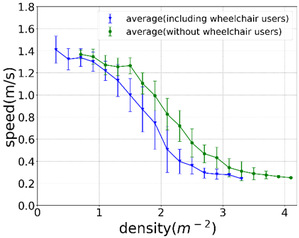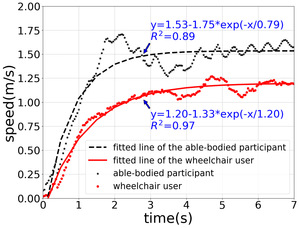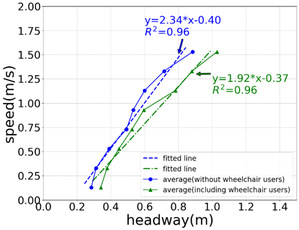Fundamental diagram of pedestrian flow including wheelchair users in straight corridors

Problem & Motivation
It is necessary to investigate the movement of people with disabilities during evacuations, considering the increasing numbers of disabled people and their vulnerabilities. The improvement of evacuation efficiency for pedestrians mixed with wheelchair users in the corridor has practical significance to public safety.
The insufficiency of the current studies mainly include the following aspects. There is a lack of further quantitative analysis of movement characteristics of pedestrians mixed with wheelchair users in the corridor under different densities and the interactions between them and their distance headway are not clear.
Methods
We conducted a series of controlled experiments by arranging six wheelchair users in the crowd and studying their normal walking in a corridor under different densities. Based on the trajectories extracted from the experiment, it is concluded that the relaxation time of able-bodied pedestrians are 24.5% shorter than the wheelchair users. The presence of wheelchair users makes the pedestrian flow have a smaller density range (0.59–4.17 m−2) and flow rate (1.49 ± 0.21 (m s)−1) according to the fundamental diagrams.
The proxemic theory is utilized to analyze the interaction between the wheelchair users and other pedestrians quantitatively. We found that the forward proxemic values of wheelchair users are smaller than their backward ones. However, both are larger than those of able-bodied participants. In the time-space relation, when the density is quite large (density > 2.22 m−2 and 2.44 m−2 for pedestrians including and excluding wheelchair users, respectively), the propagation of deceleration is faster and the ratio of low-speed movement is larger (26.1% on average) in the former. By analyzing the headway-speed relation, we found that the critical headway and safe response time (reciprocal of the proportionality constant of the headway–speed relation) are 11.76% and 20.93% longer, respectively. The above findings illustrate a lower efficiency and higher safety requirements for pedestrian flow including wheelchair users quantitatively.




Related Publication
Pan H, Zhang J, Song W, et al. Fundamental diagram of pedestrian flow including wheelchair users in straight corridors[J]. Journal of Statistical Mechanics: Theory and Experiment, 2021(3): 033411.
Download: [Paper]

